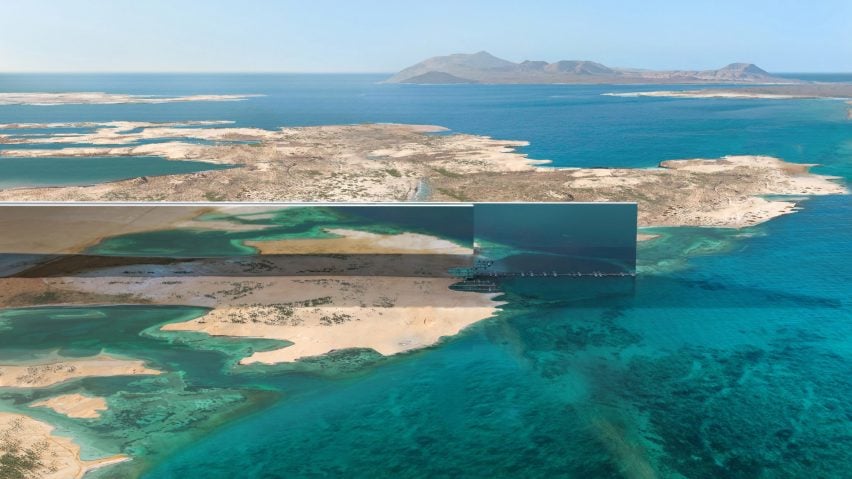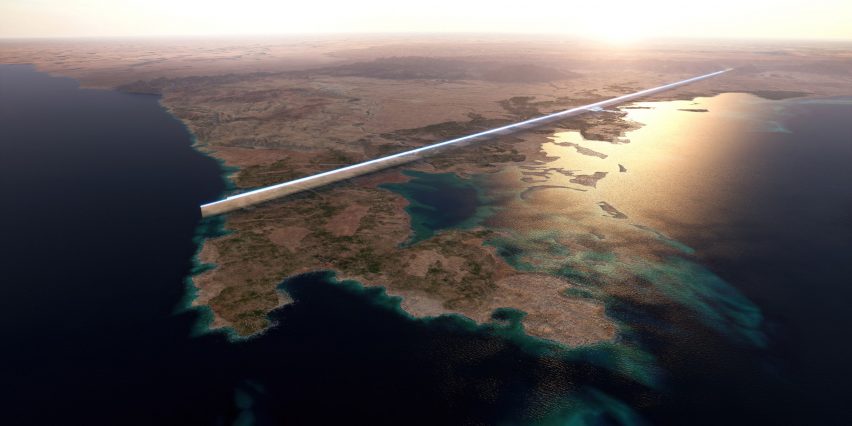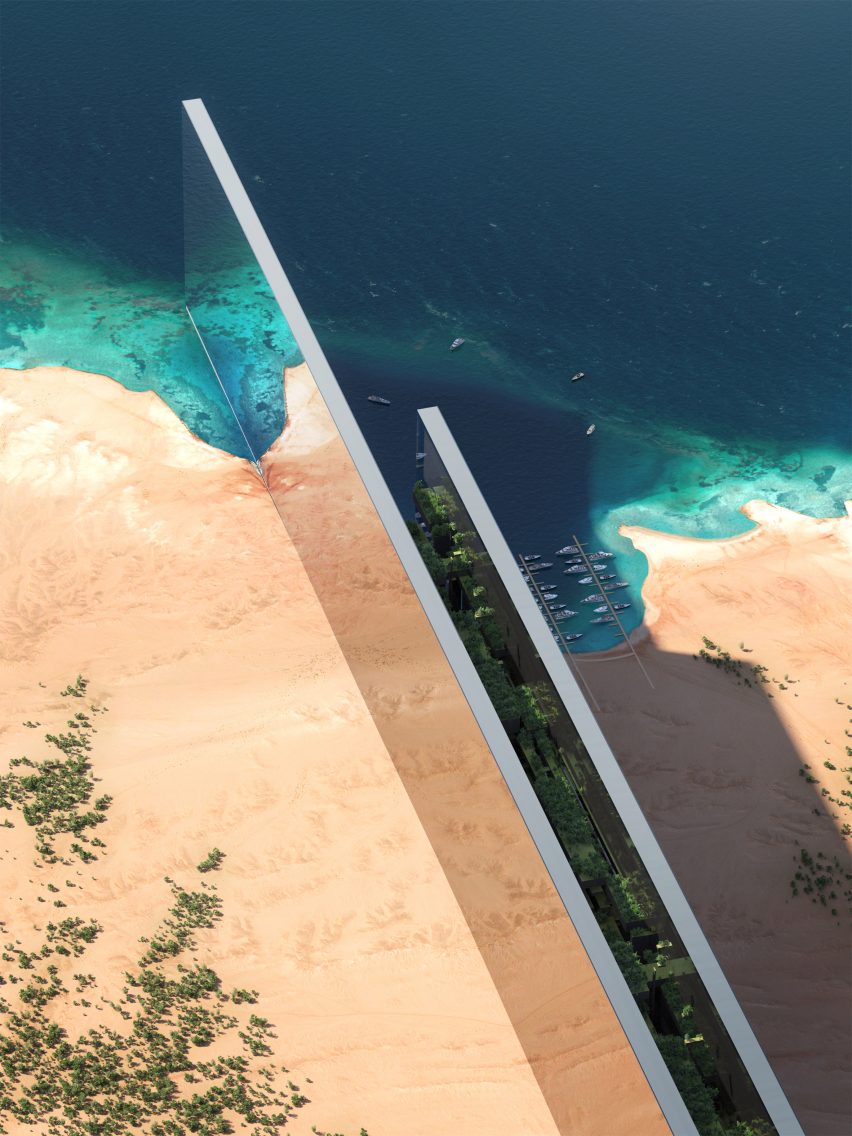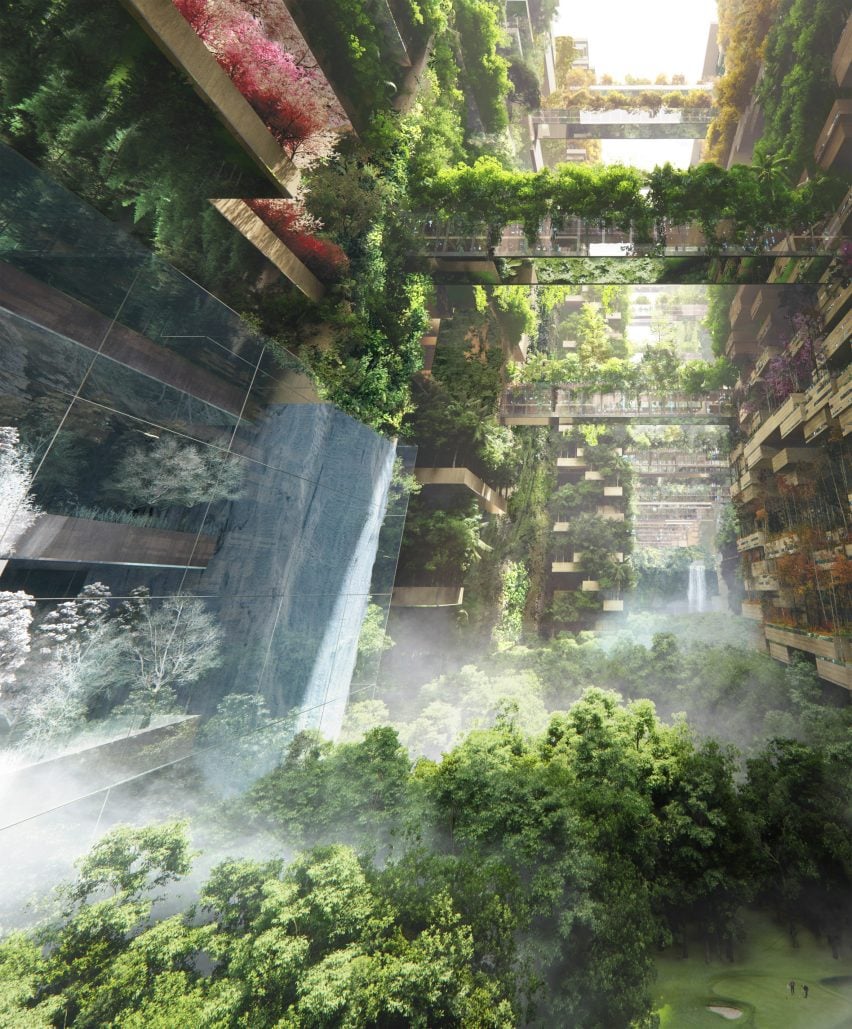
The Line megacity will "revolutionise our current way of life" says Neom director
The mirrored megacity planned for the Saudi Arabian desert will set a new standard for life in urban areas and be net-zero over its lifetime, argues developer Neom's executive director for urban planning Tarek Qaddumi in this exclusive interview.
"We see The Line as a unique opportunity to set a new benchmark for combining prosperity, livability and environmental preservation," said Qaddumi, an executive director from Neom's urban planning team.
"Irrespective of its physical stature, it will end up demonstrating that the world has the human capacity, the technology and the commitment to revolutionise our current way of life," he told Dezeen.
The Line "rethinks our urban life"
The Line is an enormous linear megastructure with mirrored cladding that is planned for a 170-kilometre stretch across the Saudi Arabian desert.
If built – as Qaddumi claims it will be – it could house nine million people.
At 500 metres tall and 200 metres wide, it will form a key part of Neom – a renewable energy-powered region under development across Saudi Arabia, Jordan and Egypt.

According to Qaddumi, The Line "rethinks our urban life from the ground up" and offers an alternative to traditional city models that fan out from a central point. This means its footprint will be just 34 square kilometres, making all daily needs accessible within a five-minute walk.
The director added that this linear layout will serve as a remedy for the many issues faced by modern cities, such as car hegemony, air pollution and urban sprawl.
"Neom has the opportunity to build a greenfield city that will not have such problems to start with," Qaddumi explained.
"The Line will have no cars, no pollution and will provide access to people and services in ways previously unimaginable."
Neom exploring carbon sequestration
The Line is also "committed to being a net-zero carbon city", Qaddumi added.
To be net-zero, a structure must eliminate all possible emissions over its lifetime. This includes both embodied carbon emissions, which are caused by the construction supply chain, and operational carbon emissions, which are caused by a structure's usage.
Academic Philip Oldfield previously told Dezeen that he expected the "vast embodied carbon" associated with building The Line to "overwhelm any environmental benefits that a small footprint provides".
Qaddumi claimed that Neom has a team dedicated to research into "green construction material" to ensure the products with the least embodied carbon are selected. The city will also be powered by renewable energy.
For the carbon emissions that cannot be avoided, the development will also employ technologies that remove atmospheric carbon.
"Whatever carbon emissions are released from the manufacturing and delivery of the structural elements will be entirely balanced out," he asserted.
"The Line construction will also be complemented by carbon offsetting and carbon sequestration, such as capturing CO2."
"Nature corridors" to be built into design
Oldfield also shared concerns over the structure's impact on biodiversity, but Qaddumi said efforts to protect local wildlife are also key to the linear city's design.
"Unlike conventional cities, The Line will ensure that nature is not watered down as it crosses the urban fabric and instead, that it is kept intact, witnessed, enjoyed and celebrated," he said.
"As an example, terrestrial animals and water flows will move through curated corridors on the ground plane."
One design feature prompting fears for wildlife is The Line's mirrored facade. This is because reflective surfaces are understood to be one of the biggest causes of bird deaths each year.

Qaddumi said The Line will be designed against this, with facade treatments that prevent collisions and "nature corridors" that align with migratory bird paths.
"These exact migration paths and patterns are being mapped by a dedicated team of scientists over the next few years," he said.
"Birds that fly at different heights will also have their designated nature corridors that are designed in combination with the right glass treatment," he explained.
Among the glass treatments that Qaddumi expects to be used in the project are ceramic frits, which are among the most common ways to make buildings more bird-friendly.
Piling work for first phase has begun
Some commentators have questioned whether The Line will ever really be built.
However, Qaddumi claimed that the feasibility studies are complete, adding that piling work for the first phase has already begun.
"There is no denying the scale and ambition of the project," he concluded. "That said, The Line's construction and financial feasibility studies are complete."
He said the team is now working with "the world's leading universities and urban research organisations" to improve the design through technologies such as digital twins, where a virtual clone of a project is made to inform decision making.

Neom's team is also exploring digitised and modular building techniques that it hopes will help minimise build time and the environmental impact of construction.
"One way the design will evolve is through moving the construction process from conventional contracting to a more robust delivery system more commonly used in manufacturing," he concluded.
"We are stepping up the digitisation of design using customised platforms, and the industrialisation of the construction process."
The Line is planned by Saudia Arabia's crown prince Mohammed bin Salman and is understood to have been designed by US studio Morphosis, though this has not been formally announced.
It is one of the latest examples of ambitious high-tech cities being developed around the world to challenge issues such as the housing crisis and climate change.
Elsewhere, Danish studio BIG is developing a 1,821-hectare development with three artificial islands built off the shore of Malaysia, while OMA is developing a car-free city in China with a "smart mobility network" that will utilise automated vehicles.
These are featured in our roundup of ten futuristic cities set to be built around the world.
Read on for the full interview with Qaddumi.
Dezeen: What do you hope The Line will achieve?
Tarek Qaddumi: The Line for us is synonymous with change. We see The Line as a unique opportunity to set a new benchmark for combining prosperity, livability and environmental preservation. We also see it as a grand opportunity for learning and contributing to the larger conversation around the future of our planet.
On the one hand, we would like to build a city that rethinks our urban life from the ground up, a city that values livability and ecology, all while promoting economic productivity. Current cities face many problems, including traffic, pollution, suburban sprawl and social disconnect. And whereas many cities are trying to remedy these issues, they remain limited by legacy planning. Neom has the opportunity to build a greenfield city that will not have such problems to start with. The Line will have no cars, no pollution and will provide access to people and services in ways previously unimaginable.
The second goal is to build a wealth of research, innovation and human capital around the future of everything. We believe that everything around us deserves to be rethought in light of our aspiration for a better human life and a different attitude toward nature. The Line will host this important work and will be a centre for this new economy.
Dezeen: Why did you decide to create a radically different form to traditional cities?
Tarek Qaddumi: The Line is a combination of two radical typologies that set it apart from other cities. This combination is what delivers the unmatched performance that The Line promises.
The Line is linear. It stretches 170 kilometres across the coastal desert, the mountains and the upper valley, allowing residents the opportunity to experience Neom while preserving the rest of the region's 26,500 square kilometres – an area the size of Belgium. Residents will be able to travel along The Line at high speed, enjoying access to the entire city at a fraction of what is needed in current cities of similar size. Once off the mobility system, residents are in "five-minute" communities and are within walking distance to all their daily needs. In addition, residents will have almost unparalleled access to nature on either side of The Line.
The Line is also three-dimensional. Residential, educational, cultural, commercial and all other assets, along with generous public space, will be organised in a vertical and three-dimensional way. This is in sharp contrast to our current accepted view of flat cities. We call this approach to cities "Zero Gravity Urbanism." It reduces the city's footprint to two per cent of that of London for a similar population. It also provides view equity and unprecedented hyper-proximity and hyper-mixed-use.
This combination of a linear and a three-dimensional city will allow for the creation of a microclimate that responds to the prevailing weather conditions. The Line will be self-shading, allowing optimal amounts of light, as well as natural ventilation, enabling the constant cooling of the public realm.
Dezeen: When do you expect construction to begin and complete?
Tarek Qaddumi: Design work on The Line has been ongoing for three years and has involved world-leading architects, engineering firms and consultants. Last year witnessed the commencement of the construction work on The Spine, the infrastructure corridor of The Line. In April this year, the piling work for the first phase of The Line began, in addition to excavation of the Hidden Marina, the first anchor project along the linear city. The Line's initial phase is planned for 2030, when we expect its first substantial population. The city will continue to grow organically from there to reach its nine million population capacity.
Dezeen: How do you expect the design of The Line to evolve before it is built, or do you expect it will be built in its current form?
Tarek Qaddumi: We see Neom as a living lab – a place for daily exploration. While we embark on this incredible journey of discovery, we expect to learn every day and develop new ideas to promote the environment around The Line and to enhance the livability within it and beyond.
One way the design will evolve is through moving the construction process from conventional contracting to a more robust delivery system more commonly used in manufacturing. We are stepping up the digitisation of design using customised platforms, and the industrialisation of the construction process. By doing so, we hope to achieve faster, better and more economical results, with less environmental impact.
Dezeen: Have you considered the impact the mirrored facade would have on the area's bird life?
Tarek Qaddumi: Neom is committed to nature preservation and stewardship. The Line will be a place where nature and the urban world intersect. Unlike conventional cities, The Line will ensure that nature is not watered down as it crosses the urban fabric and instead, that it is kept intact, witnessed, enjoyed and celebrated.
As an example, terrestrial animals and waterflows will move through curated corridors on the ground plane. Equally, birds that fly at different heights will also have their designated nature corridors that are designed in combination with the right glass treatment, ceramic frit, glass transparency and reflectance factors. The movement of birds becomes a seasonal celebration during migration season. These exact migration paths and patterns are being mapped by a dedicated team of scientists over the next few years.
Dezeen: Is there a need for a new city for nine million people in northwest Saudi Arabia?
Tarek Qaddumi: As one of the fastest-growing countries in the world, Saudi Arabia has a significant and rapidly expanding population size for which local demand for urban space is already outgrowing supply. The Line will contribute to the sustainable growth of the country in a region that sits at the crossroads of Europe, Asia and Africa. It will be able to be reached by a six-hour flight for 40 per cent of the world's population and is in a strategic location that gives it access to 13 per cent of the world's global trade routes.
Dezeen: Is constructing a structure this large feasible?
Tarek Qaddumi: There is no denying the scale and ambition of the project. In fact, it is currently the world's largest urban undertaking today. That said, The Line's construction and financial feasibility studies are complete.
We are now looking to further improve and rationalise constructability, building logistics and in-country material production. We are also continuously engaged in better understanding and testing of our livability and environmental metrics through digital twins and other technologies. Engaged with us are globally renowned experts from the world's leading universities and urban research organisations.
Dezeen: Have you calculated the number of materials needed and the carbon impact of the structure?
Tarek Qaddumi: In addition to Neom being powered by 100 per cent renewable energy, The Line is committed to being a net-zero carbon city. This means that whatever carbon emissions are released from the manufacturing and delivery of the structural elements will be entirely balanced out by other means.
To do so, The Line will be looking to source materials such as concrete and steel with the least embedded carbon. We have a material research team that's looking into and promoting innovation of green construction material.
The Line construction will also be complemented by carbon offsetting and carbon sequestration, such as capturing CO2.
Dezeen: Are you aiming to send a message by creating what would be the world's largest building?
Tarek Qaddumi: Although perceived as a building, The Line is in fact a city that is organised three-dimensionally, making it seem like a building.
Given our population ambition, The Line has to be a certain size. But irrespective of its physical stature, it will end up demonstrating that the world has the human capacity, the technology and the commitment to revolutionise our current way of life.
The visuals are by Neom.
Dezeen in Depth
If you enjoy reading Dezeen's interviews, opinions and features, subscribe to Dezeen In Depth. Sent on the last Friday of each month, this newsletter provides a single place to read about the design and architecture stories behind the headlines.